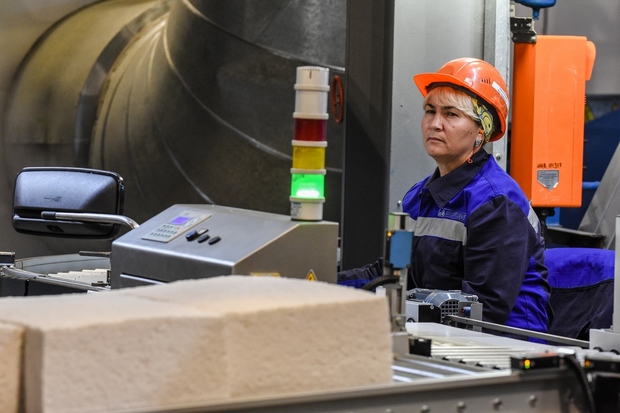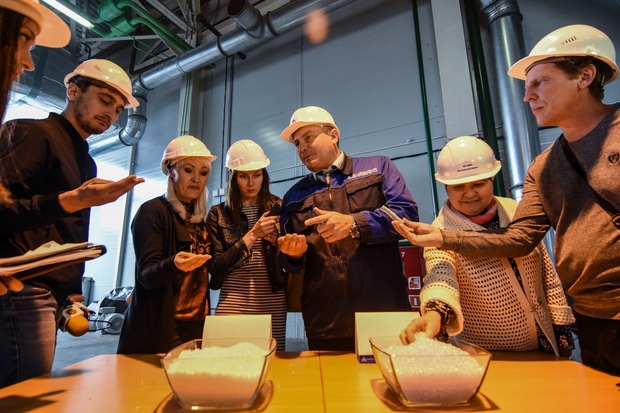Nizhnekamskneftekhim: how the petrochemical giant works
In honour of the 50th anniversary of the town-forming company, it was organised a press tour where the veil of secrecy of how the large industrial company works was lifted. Reporters were shown the plants for production of rubbers and plastics. Certainly, this is only a small part of the petrochemical giant, the work of which is provided by more than 15,000 people. The chemical plant, the history of which began a century ago with liquefied gases now produces the world-famous rubber. The tire covers for passenger cars and tyres for Formula One are produced of that rubber. How much a briquet of the rubber weights, how the programme of import substitution is being implemented at Nizhnekamskneftekhim and what products are made from foodstuff rubber as well as many other things — read in the material of Realnoe Vremya.
Raw material plant for the enterprise
The first point for the journalists was the central gas fractionation unit (CGFU). Fifty years ago the history of Nizhnekamskneftekhim began with it. On 31 July 1967, from raw materials of the Minnibaevsk gas processing plant it was produced propane, butane, isobutane, pentane, isopentane and hexane. Then they were poured into tanks and sent to Omsk and Ufa, and over time at the chemical plant there were built plants, where from the fractions received from the unit they began to produce rubbers, plastics and other products.
''We are the raw material plant for the chemical combine,'' explains the director of the plant for production of butadiene and hydrocarbons of Nizhnekamskneftekhim Leonid Kutuev. ''With almost every plant we are linked directly, so we watch how they are developed and do not lag behind, do our work, so as not to hinder the development of the entire enterprise. Since the products serve as feedstock for other plants, then, for example, the expanding manufacturing capacity for production of isoprene-monomer forces us to increase the volumes.''

The CGFU is constantly upgraded, so over time the production became automated. The director of the plant recalls how once in the control room there were a large shield and noisy devices necessary for control. Now the experts see everything that happens at units on computer monitor. The raw material comes from Siberia, the Volga region and Nizhnekamsk TAIF-NK. About 1,5 million tonnes of raw materials are processed at the CGFU, the lion's share of which goes for production of synthetic rubber, the main products of Nizhnekamskneftekhim PJSC.
One-third of isoprene rubber in the world
Isopentane, hexane, and pentane, obtained at the CGFU, are sent to the synthetic rubber plant. Then specialists process this source material into 30-pound briquettes.
''It is SKI-3, an analogue of natural rubber,'' explains director of the plant of synthetic rubber Nizhnekamskneftekhim Sergey Zaytsev. ''In the modern world the industrial rubber products, tyres are very common. Who has a car?' he suddenly asked the reporters. ''Everyone, everyone needs wheels, so SKI-3 is mainly used in the tyre industry.''
The plant produces three types of rubber: SKI-3, SKDN, SKDL. Major consumers are tyre giants such as Michelin, Pirelli, Continental, Bridgestone, Goodyear.
''A tyre of any car has a share of our rubber produced in Nizhnekamsk,'' said Sergey Zaytsev.

Automated production
Nizhnekamskneftekhim produces seven kinds of synthetic rubbers and constantly increases their volumes. By 2021, it is planned to increase the production of rubbers up to 1 million tonnes, so the production is constantly upgraded. So, at the end of 2012, for the shop of receiving, packing and packaging of finished products of the butyl rubber plant it was purchased automated equipment, which allows to take from a pipeline 30-pound briquettes and pack them into a container. Workers had to do all it themselves before. Now 20 people have been replaced by 3 robots, these people were transferred to other jobs.
''When briquettes were thrown by hand, there were problems: the film was constantly torn. But it was resolved after the installation of robots. We have done a great job on improving the appearance of briquettes,'' says the director of butyl rubber plant Nizhnekamskneftekhim Irek Aglyamov.
The products of his plant — butyl and halobutyl rubbers — also are purchased by global tyre giants. In addition, several years ago, the company established the production of foodstuff rubber for chewing gums as well as rubber for the pharmaceutical industry.

Replacement of imported goods
The second important product for the company — plastics, so the journalists were shown the plant of plastics, which produces ABS plastic, polystyrene, polypropylene and polyethylene. In total, they produce 730,000 tonnes a year. This allows almost completely to cover the needs of the Russian market in polypropylene and polyethylene. The share of Nizhnekamskneftekhim accounts for about 80% of the total polystyrene consumption in Russia.
''It is high-impact polystyrene, it is made from styrene with rubber, that is why it is white,'' said the director of the plant of plastics Nizhnekamskneftekhim Ruslan Borodin showing a scattering of pellets.

Packaging for yoghurt, disposable cups, CDs are produced of high-impact polystyrene. The plant produces the most popular plastic — general purpose polystyrene, which is basically used for insulation. Almost all the products remain in Russia.
''The programme of import substitution is being successfully implemented. We are mastering the production of those brands, which in Russia had been imported. Most importantly, it is a big development for us. First, it is research and development works, the search for new catalysts, additives, because in the past these brands of polypropylene, polyethylene were not produced,'' explains Ruslan Borodin.
At the cost of new products at Nizhnekamskneftekhim they plan to expand not only the range of products but also markets for distribution. The company plans a capacity expansion: to increase the volume of plastics up to 1,5 million tonnes by 2021 and up to 2,5 million by 2025, which will make possible to make plastics the main product of Nizhnekamskneftekhim.